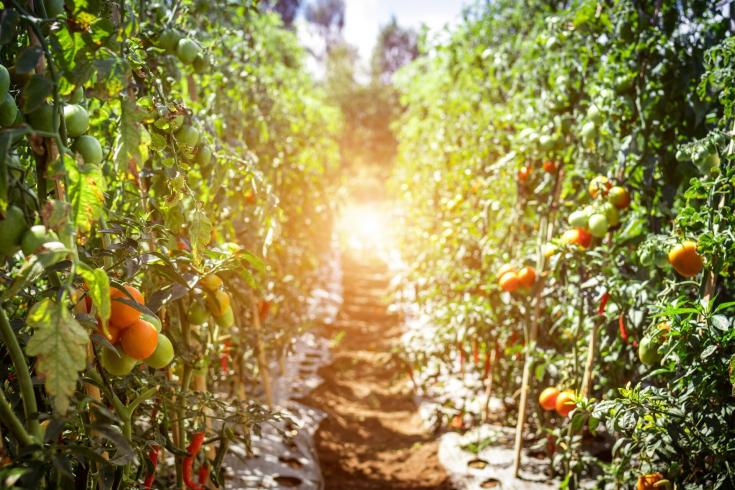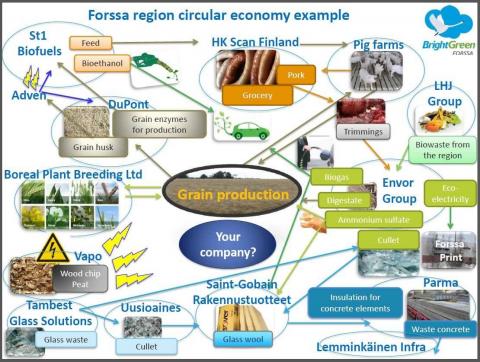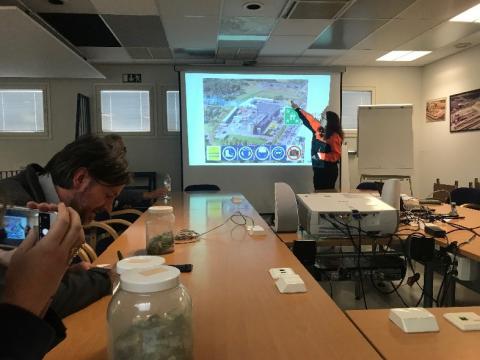From food production to glass wool production

What is Industrial Symbiosis and why it matters for regions?
Industrial symbiosis (IS) represents a shift from the traditional industrial model (enterprises generate waste which is deposited or incinerated), to integrated systems in which the waste of one company becomes the resource for another. These integrated systems offer business opportunities that leverage underutilised resources such as materials, energy, water, capacity, expertise or assets (Lombardi & Laybourn, 2012).
IS thus promotes more sustainable use of resources and is a major way of stimulating circular economy. IS may involve different industry players, belonging to different sectors of activity as well as governmental and other institutions such as universities, trade associations, etc. Although public authorities in charge of economic development and industrial policies play a strategic role in IS development, there are not many countries that prioritise direct support for IS in their policy agendas.
In some countries, regional or local authorities have taken initiative to support bottom-up approaches to IS, often without directly targeting IS, but allowing companies and business parks to self-organise into IS networks (Johnsen (ed), 2016). For example, the Kemi-Tornio region in Finland provides direct support to Kemi-Tornio Technology Park that has been a key facilitator of IS synergies. This good practice was shared among the partners of the Interreg Europe SYMBI project.
In other cases, IS has developed spontaneously at regional level as it was with IS development in Forssa described below. There are regions in Europe where the competent national, regional or local administration has included IS as part of eco-industrial parks, or support the IS development through programmes such the Finnish FISS, the Danish Green IS Programme, the Hungarian NISP, etc.
Developing Industrial Symbiosis in Forssa, Finland
The Finnish Häme region, represented by two partners in the Interreg Europe SYMBI project, has been developing an IS system for many years. To strengthen its case, circular economy and IS are embedded in the Regional Development Strategy, the Regional Innovation Strategy for Smart Specialisation (RIS3), and in the Regional Land Use Strategy.
This very interesting policy achievement has been highlighted by Ms. Harri Mattila from Häme university, one of the partners in SYMBI project, during a workshop on IS organised by Interreg Europe Policy Learning Platform on 22 May 2018 in Helskinki. To deepen the thematic exchange and learn from practitioners on the ground, the participants at the workshop had also the opportunity to visit the Eco-industrial Park in Forssa in Häme region. Forssa is located in southern Finland, in the middle of the central area for grain production.
IS synergies were presented and discussed during the visit with the representatives of Envor Group, the regional waste management company, LHJ and Saint Gobain Finland Ltd., producing glass wool. What is extremely interesting is that the Häme regional council and the local municipality play a crucial role for the development of the Park in terms of ensuring a sound policy framework, e.g. related to land use planning (municipal level).
Being of notable regional impact, the Park ensures IS between companies generating secondary materials such as fertilizers, biogas and biofuels. The symbiosis is formed between companies from different sectors: food production, biogas production and glass wool production.

Source: SYMBI project
Specifically, Forssa IS brings together diverse businesses in material recycling and waste processing, bio-economy and renewable energy. Cooperation of Forssa IS with HAMK university is essential for the success of IS in Forssa as the university also acts as a facilitator of IS synergies and the results of research activities are embedded in the industrial processes leading to environmental and economic gains. Universities and Saint Gobain Finland Ltd., which is located in the Park, cooperate under Horizon 2020 projects (e.g. WOOL2LOOP, an innovation project that focuses on the recovery of mineral wool waste from the construction industry).
An example of IS synergies between two companies located in the eco-industrial park in Forssa is described below.
The family-owned biogas production company, Envor Group Oy, produces biogas and biofuels from bio-waste and sludge. Most of the biogas goes directly to the Forssa production plant of Saint Gobain Finland Ltd. as energy for the manufacturing process of glass wool insulation. Having close connections, it was of common interest for Envor Group and Saint Gobain Finland Ltd. to build a pipe that enables Saint Gobain Finland Ltd. to use biogas as a substitute to propane and thus reduce CO2 emissions. The 2.5 km long biogas pipe was built in 2010. The investment of 250 000 EUR was a joint venture. Saint Gobain Finland Ltd. has decreased CO2 emissions by 50% in the period 2010 – 2018 as a result of using biogas instead of propane.

Ms. Helly Kettunen from Saint Gobain explains IS synergies to Interreg project
partners and other stakeholders
In 2010, the Forssa factory of Saint Gobain Finland Ltd. was the first glass wool production plant in the world where fossil fuel was replaced with renewable energy. In the production of glass wool, Saint Gobain Finland Ltd. also uses recycled glass provided by Uusioaines Oy and Envor Group. In addition, the ammonium sulphate recovered from the biogas process of Envor is also used as a binding agent of glass wool. The Envor biogas plant also generates electricity to the grid.
The eco-industrial park in Forssa as an inspiration for local and regional policymakers
This practice demonstrates the environmental and economic benefits of IS synergies. It could be useful for regions and cities willing to step up efforts in IS development with focus on planning of regional industrial sites. The proximity of the companies enables an optimized way to transfer secondary resources from one to the other, also by building infrastructure for exchange of resources. As part of their responsibilities with regards to land-use planning, municipalities in Finland are taking steps to reserve areas large enough for operation of these types of companies.
This is a remarkable action of the municipalities in Forssa and an inspiring example for other regions. The role of land-use planning in the region as an enabling factor for IS development was also highlighted by Ms. Sirkka Köykkä, the town architect of Forssa. As demonstrated above, the public sector ability to support material recycling by adopting policies to reduce the amount of waste in landfills and organising collection of various separated materials creates supportive attitude for this type of activities.
Public authorities and other stakeholders involved in eco-industrial park initiatives need also to embed the IS approach in all stages of their development. A positive example in this regard is 'Les Portes de Tarn' business park in the South of France, in which lS has been integrated at:
- Concept phase: develop an industrial water network and a heat network;
- Construction phase: earth linked to the construction would not leave the zone and would be reused for other purposes;
- Commercialisation phase: IS is integrated as a criterion for the tenant selection. Tools for decision making have been developed (the software EFFIE for the choice of the best land plot in order to achieve the best possible synergies).
More information about Forssa IS here.
